NZFFA Member Blogs
Member Blogs
-
Brian Cox's Blog
-
Chris Perley's Blog
-
Dean Satchell's blog
-
Denis Hocking's blog
-
Dennis Neilson's blog
-
Eric Cairn's Blog
-
Grant Hunters blog
-
Hamish Levack's Blog
-
Howard Moore's blog
-
Ian Brennon's blog
-
Ian Brown's Blog
-
Jeff Tombleson's blog
-
John Ellegard's blog
-
John Fairweather's blog
-
John Purey-Cust Ponders
-
Murray Grant's Blog
-
Nick Ledgard's Blog
-
Rik Deaton's Blog
-
Roger May's Blog
-
School of Forestry blog
-
Shem Kerr's blog
-
Vaughan Kearns blog
-
Wink Sutton's Blog
Recent blogs:
Wooden skyscrapers are wonderful, but...
Wink Sutton's BlogWednesday, May 30, 2012
Google the ‘the world’s tallest building’ and responses include proposals for a 16 to 17 storey building in Norway and for the Creative Renewable Energy and Efficiency group’s plan for a 30 storey building in Austria. Google ‘Vancouver wooden skyscraper’ and the response includes architect Michael Green’s proposal for a 30 storey wooden skyscraper in Vancouver, British Columbia.
As wood suppliers we should welcome proposals that finally recognise the major environmental advantages of wood, such as its low energy requirements, sustainability, carbon sequestration and earthquake benefits. As many of us have advocated for years for the environmental advantages of using wood we must ask why have wood’s advantages taken so long to be accepted?
The promoters of wooden structures are architects and engineers, professions that have little or no understanding of forestry. If there is a move to build large wooden structures we are looking at a quantum increase in wood demand. We would almost certainly see a reversal of the long-term decline in per capita consumption of industrial wood.
The first record of global wood consumption was in 1920. Since 1920 the wood harvest has doubled, but over that same period the global population has increased almost four-fold, so the per capita consumption has almost halved in the last 90 years.
Several projections of the future global wood supply suggest that the global wood harvest could increase slightly over the next 20 years. However, the forest industry could not supply the quantum increase in wood demand that will almost certainly result if there is a trend towards large wooden buildings. Other than those just grown on short rotations for pulping or reconstituted wood products, trees require at least two decades before they are large enough for conversion.
Almost all the trees that will be harvested in the next 20 years are already growing which is why future wood harvests can be so confidently predicted. Even if there is a large increase in the establishment of plantations these will not be available for harvest for at least the next 20 years.
Adding to the world problems is that a significant increase in plantations will require a massive investment as tree growing is the most capital intensive industry there is. Governments have no interest in long-term investments such as plantation establishment. The private sector tends to buy plantations which already exist rather than invest in the creation of new plantations. In contrast, the increased production of steel and cement requires less capital and more importantly only one to four years before production can start.
Wooden skyscrapers are a wonderful development, but more consideration should be given to where the required wood might come from.
Tree shelter is important
Wink Sutton's BlogTuesday, November 29, 2011
Farm foresters are aware of the importance of shelter on farms and it may seem inappropriate to raise the subject of shelter in this magazine. However some farms, perhaps many, still appear to provide inadequate animal shelter. Harry Bunn and Neil Barr were constant critics of this lack of shelter and claimed that farm owners had been falsely convinced that trees on farms resulted in a loss of productivity.
Several decades ago I remember seeing a short film produced by the NZFFA with sheep and cattle attempting to escape the heat of a summer sun by sheltering in the shade of the one tree in a paddock. A time-lapse sequence showed the animals moving to follow the tree’s shadow as the sun moved across the sky.
I also remember Peter Smail extolling the value of shelter during lambing when pregnant ewes were about to give birth they were transferred to the shelter in his plantations. Peter said that just before they were about to give birth ewes select the birthing site. If the weather then turned unfavourable between site selection and birth, the birth still occurred sometimes with disastrous consequences. Peter claimed that by birthing in the shelter of plantations he had greater lambing successes.
In the late 1950s I occasionally travelled by rail between Wellington and home near Hastings. The trip was unmemorable usually, but one incident left a lasting impression. It was a hot summer day and we were travelling through farmland in southern Hawke’s Bay. The young English couple opposite me became more and more agitated. They were very critical of the total absence of shelter on many of the farms.
As a nation we have not adequately addressed this shelter issue. With the rising importance of animal welfare in international trade we must do more about animal shelter. Adverse publicity from both our competitors and animal welfare organisations could have very serious consequences for New Zealand.

No posts yet
Disclaimer: Personal views expressed in this blog are those of the writers and do not necessarily represent those of the NZ Farm Forestry Association.

 Farm Forestry New Zealand
Farm Forestry New Zealand
No posts yet
Add a post